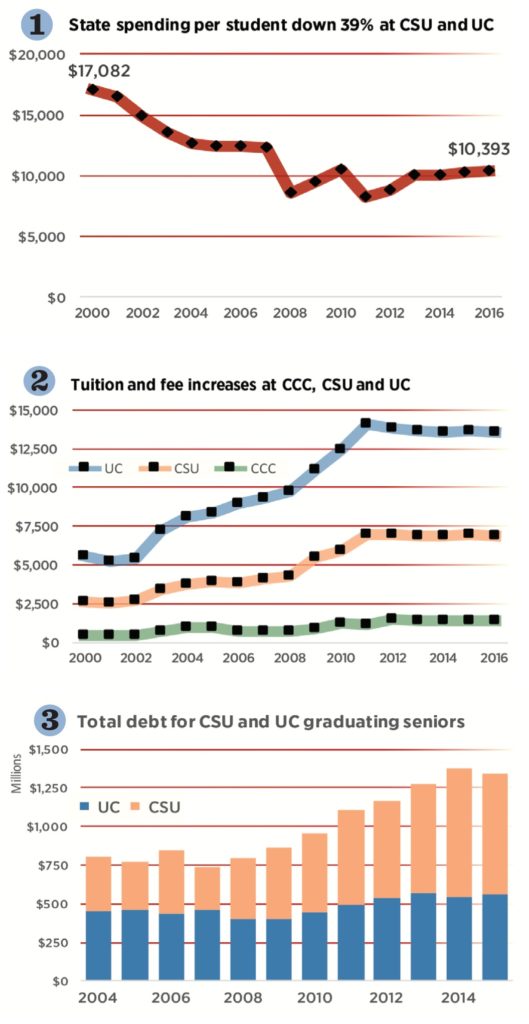A college degree without the debt
The $66 Fix, a carefully-researched report, proves that California can afford to restore top-quality public higher education—and make the system 100% tuition-free…
Built on the 1960 Master Plan, California’s three-segment public system of higher education — the Community Colleges, the California State University and the University of California — was for decades the opportunity-and-growth blueprint for California’s prosperity.
What’s the problem?
• Universities looted | Over the last fifteen years, California’s political leaders have taken $57 billion in public investment away from higher education.
• Drastic cuts to CSU and UC spending per student | State spending per university student has been cut by nearly 40 percent—it’s now less than the state spends on the average 3rd Grader. See chart 1.
• Soaring tuitions | Student fees at community colleges have tripled (from $460 to $1,380). At the CSU, student tuition and fees have jumped nearly 170 percent (from $2,565 to $6,881); at UC they’ve climbed nearly 150 percent (from $5,529 to $13,566). See chart 2.
• Exploding student debt | In 2016, nearly 70,000 seniors graduated from the CSU and UC with $1.3 billion in student debt, up by more than 60 percent since 2004. In the last dozen years, California public university graduates started out life with a total of $12 billion in debt. See chart 3.
Today, voters give higher education the highest priority.
Voters understand that California’s public higher education system is key to the state’s quality of life and economic vitality. Voter opinion polls rank restoring higher education ahead of other state priorities, including highspeed rail, water projects, and rebuilding roads and bridges.
California can fix this problem. We know what works.
Take 4 steps to restore top-quality, public higher education to every qualified California student:
1. Make colleges and universities 100% tuition-free, as the 1960 Master Plan intended, eliminating almost all new student debt.
2. Return per-student funding for CSU and UC to where is was in 2000 (adjusted for inflation) before California’s political leaders started investing billions of dollars less in our colleges and universities.
3. Ensure there’s an opportunity to attend a public college or university for every in-state student ready and willing to do the work, just like California generations before them.
4. Send K-14 schools their Prop 98 share of dollars to help prepare more California kids for college.
California can afford the best. In fact, if we want to compete in the world today, can we afford any less?
We abandoned higher education. Our competitors didn’t. | When California followed its own 1960 Master Plan for Higher Education, we were a model for the world. Now those states and countries that built their own higher education systems on our blueprint—and never forgot its lessons—have become our state’s best equipped competitors, developing new industries and battling for jobs.
Will this generation be better off than its parents? | Economists now say that unless we get public higher education back on track in California, the rising generation will be less educated than the one before it. Californians will be less valuable to employers and less equipped as public citizens to meet complex challenges. Higher education policy is one of those challenges—and we must meet it today.
Why is it called “the $66 fix”? Because that’s all it costs the median California family to reclaim the higher education that every California family dreams of.
California has the resources to restore our world-class higher education system. Will it be cheap? No, simply because California is by far the biggest state in the country. Multiply anything by 38 million people and you get a big number. But if you divide a big number by 38 million people, and do it fairly, extremely valuable things can be surprisingly affordable.
Example: The cost to restore state support to higher education and also make public higher education tuition-free for in-state students, as the Master Plan intended, will cost two-thirds of households $185 or less on April 15. Half of all California families would pay $66 a year or less.
Is a brighter future for California worth $66 a year? We ask you to get the facts and decide for yourself. Download our two-page fact sheet (the information you just read), or view your free copy of our full policy paper The $66 fix: Reclaiming California’s Master Plan for higher education.
(Note: All dollars in this fact sheet are real dollars, adjusted for inflation.)
